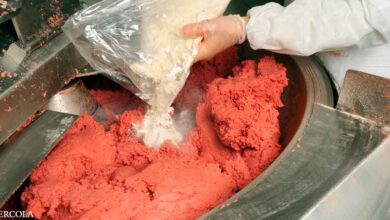Can Ginseng Help Control Diabetes?

Diabetes has become a “huge public health challenge”, with 463 million adults living with Type 2 diabetes worldwide. This number is expected to grow to 700 million people by 2045 and does not take into account many others with prediabetes, which increases the risk of developing type 2 diabetes.first
If not managed, diabetes can lead to serious complications that can damage the eyes, kidneys, and nerves, and increase the risk of heart disease, stroke, and amputation.2 Inactivity and poor diet are fueling the diabetes crisis, causing people to develop the condition at a younger age.
Diets that focus on ultra-processed and fast foods are at the root of the problem, as they’re high in seed oils — erroneously called “vegetable oils” — that contain omega-6 linoleic acid (LA). Toxic oxidation accelerates metabolic dysfunction.3 Diet and lifestyle changes are essential to managing type 2 diabetes and may even lead to a reversal of the condition.
However, conventional medicine focuses on treating diabetes with drugs, which have no curative effect and can be toxic. Traditional herbal medicine, especially ginseng, is a welcome alternative that offers powerful antidiabetic effects.
Ginseng contains hundreds of beneficial ginsenosides
Ginseng has a long history of medicinal use.4 including in China, where it was used to cure Xiaoke – known today as diabetes – in the Song Dynasty circa 1078 AD Both Asian ginseng (Panax ginseng) and American ginseng (Panax quinquefolius L.) both have promising anti-diabetic effects and health benefits – promoting compounds such as saponins, polysaccharides, polyacetylenes, phenols, and alkaloids.
Nearly 200 ginseng ginsenosides, also known as saponins or triterpenoids, have been found in the ginseng plant and are thought to be responsible for some of the herb’s anti-diabetic properties. These include regulation of insulin secretion and glucose uptake along with protective potential against oxidative stress and anti-inflammatory properties.
Ginseng berries, which contain more ginsenosides than even ginseng root, may be especially beneficial. In a study in diabetic rats, those treated with 150 milligrams (mg per kg) of body weight ginseng berry extract for 12 days experienced a significant reduction in fasting blood sugar. .
The same dose of ginseng root extract did not lead to the same reduction on day 12, the researchers suggesting that “ginseng berry extract has stronger anti-hyperglycemic effects than the extract from Ginseng root is used at the same concentration.”5
However, in a trial involving people with prediabetes, ginseng berry extract did not show blood sugar-lowering effects, which the researchers suggest may mean the compound works best. against type 2 diabetes, not prediabetes.6
Anti-diabetic effects of ginseng may support type 2 diabetes
In a review of the anti-diabetic effects of ginseng published in the journal Molecules, researchers from New Zealand found evidence for the anti-diabetic effects of ginseng extract and ginsenosides.7
Among the studies evaluated was a meta-analysis of 16 randomized, controlled clinical trials that found ginseng significantly lower fasting blood sugar compared with controls, and a meta-analysis. Another of eight trials found that ginseng supplementation resulted in greater reductions in fasting and postprandial blood glucose than in insulin compared with controls.8
A product called ginsam – an enriched ginsenoside – also provided benefits in a trial of 36 patients with diabetes. Compared with the placebo group, those taking ginsam had significant reductions in HbA1c levels and fasting blood sugar.9 Fermented red ginseng also showed benefit and significantly increased postprandial insulin levels in type 2 diabetics after 4 weeks. It also reduced their postprandial sugar intake by 17.2% from baseline.ten
Trials involving American ginseng are also very promising. Among 24 adults with well-controlled type 2 diabetes, those who received 3 grams of American ginseng extract daily for 8 weeks along with their usual treatment had significantly reduced levels of HbA1c, the sugar fasting blood pressure and systolic blood pressure compared with those receiving placebo. , and no adverse effects were found on liver or kidney function.11
Taken together, the researchers concluded that ginseng appears to be a strong natural option for Type 2 diabetes, although larger and longer, more studies are needed:twelfth
“These studies show that American ginseng extract is effective and safe as an add-on treatment in the management of type 2 diabetes… Along with that, human studies show that both Asian ginseng and American ginseng actually lower blood sugar in type 2 diabetics.
Also, it should be noted that this effect was observed in a limited number of ginsenosides (6-7 ginsenosides analyzed), small sample sizes (23-94 subjects), and short-term studies (4- 12 weeks). Larger-scale clinical trials are needed to fully elucidate the long-term benefits of this herbal supplement in managing type 2 diabetes.”
How Ginseng Can Fight Diabetes
Ginseng has multiple mechanisms of influencing diabetes, including regulating blood glucose levels by improving the function of pancreatic beta cells, which produce, store, and release insulin. In addition, it enhances insulin sensitivity, while ginseng fruit extract increases beta cell proliferation and insulin secretion, which improves blood sugar control.13
Ginseng also regulates the expression of glucose transporters, which enhance glucose absorption, while suppressing oxidative stress and modulating inflammation to help prevent the development of insulin resistance. However, there is some conflicting research suggesting that the size of ginsenosides may make a difference in their antidiabetic effects.
In particular, ginsenosides Rb1, Re or Rg1 are among the most widely studied, but due to their large molecular structure they have poor bioavailability. In fact, the smaller molecule ginsenosides Rg3 and Rh1 may be the ones with the most therapeutic effect. Fermentation produces small ginsenosides, which explains why fermented ginseng increases bioavailability, including absorption and bioactivity. According to New Zealand researchers:14
“It appears that the large molecule ginsenosides (Rb1, Rc, Re) may be the storage form of saponins in ginseng rather than the active form in vivo. Related but smaller molecule ginsenosides (Rg3, Rh1) may be the therapeutic component. ”
What else is ginseng good for?
The ginsenosides in ginseng have a wide range of physiological activities, including effects on the nervous system, cardiovascular system, and immune system. Ginseng polysaccharides also have multiple biological activities and may help regulate the immune system while providing anticancer, antidepressant, and antioxidant effects.
Ginseng may be beneficial for age-related neurological disorders, including Alzheimer’s disease, and even protect against radiation-induced skin damage.15 and anti-obesity.16 Like many herbs, ginseng can act as an overall health tonic, with antibacterial, anticancer, and neuroprotective effects. Another review, focusing on American ginseng (AG), also advertised its health potential, stating:17
“AG has a high potential to induce beneficial health effects in humans and further exploration is needed to make precise nutritional recommendations, as well as to assess its value in preventing and treat a number of disorders, including cancer.”
Together, the many complex active ingredients in ginseng may have the following effects:18
|
Anti-tumor |
Against aging |
|
Prevention of traumatic brain injury caused by ischemia |
Immune conditioning |
|
Central nervous system regulation |
Inhibits liver damage |
|
Improve damage caused by myocardial ischemia |
Leukemia |
|
Regulate growth and metabolism |
Infection |
Diabetes is reversible with the right strategy
Ginseng should only be part of a comprehensive plan to support your health, especially if you are dealing with a complex disorder such as diabetes. Type 2 diabetes is a manageable – and often reversible – condition as long as you make positive lifestyle changes and receive appropriate medical advice and care.
As it stands, diabetes treatment costs $230 billion each year in the United States, but the death rate from diabetes is 42 percent higher than in 10 other industrialized countries,19 provides a testament to the sad state of diabetes care. Fasting, or time-restricted eating (TRE), should be an essential part of diabetes treatment, but it’s something that’s rarely mentioned in the usual circles.
TRE is a powerful intervention that simply mimics our ancestors’ eating habits and restores your body to a more natural state that allows for the full range of metabolic benefits to occur.20 TRE involves limiting the length of your eating to six to eight hours per day instead of the more commonly used 12-hour period.
TRE promotes insulin sensitivity and improves blood sugar management by increasing the rate of insulin-mediated glucose uptake,21 this is important for tackling type 2 diabetes. In another study, when 15 men at risk of type 2 diabetes restricted their intake even to a nine-hour period, they reduced their average fasting blood sugar, regardless of when the “eating window” started.22
Also, as mentioned, there is almost nothing that wreaks havoc on your body more than the linoleic acid in seed oil causing chronic diseases like diabetes.23 Linoleic acid is found in almost every processed food, including restaurant foods, sauces and salad dressings, and hidden in “healthy” foods like chicken and pork. In addition to capturing TRE, reducing LA is essential for diabetes prevention and management.
At best, consider cutting linoleic acid down to 2 or 3 grams per day, which is close to the levels our ancestors had before all these chronic health conditions, including obesity, diabetes, and obesity. , heart disease and cancer, became common.
If you’re not sure how much you’re eating, enter your intake into Cronometer – a free online nutrition tracker – and it will give you your total linoleic acid intake. The key to accurate input is to carefully weigh your food with a digital kitchen scale so you can enter the weight of your food to the nearest gram.
The Chronometer will tell you how much omega-6 you’re getting from your food down to 10 grams, and you can assume 90% of that is linoleic acid. Anything over 10 grams can cause problems, so you’ll want to avoid foods high in LA. This means removing all of the following oils:
|
Soy bean |
Corn |
Canola oil |
|
Safflower |
Sunflower |
Peanuts |
Other high LA foods include french fries in vegetable oil, commercial dressings and salad dressings, virtually all processed foods, and any fried fast food, such as french fries. Remember that a targeted diet using beneficial herbs like ginseng can greatly support optimal health, but you’ll also want to address the dietary basics. and lifestyle is the root of the problem.




